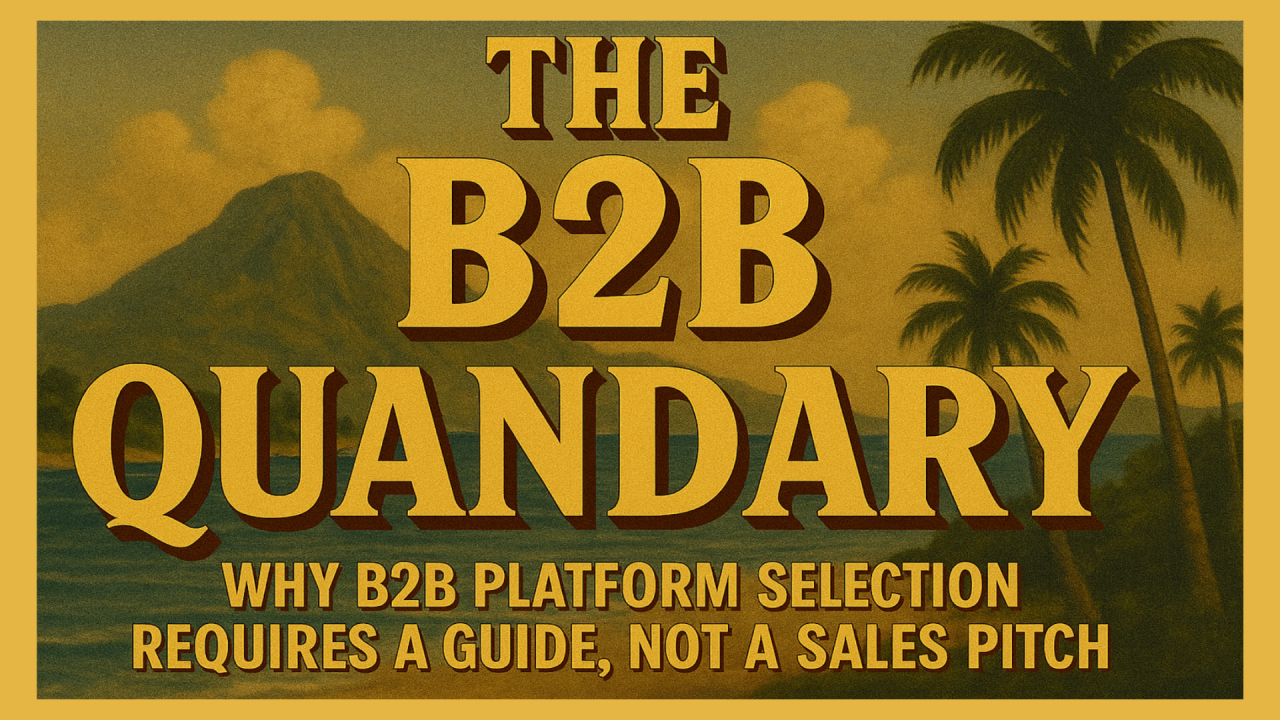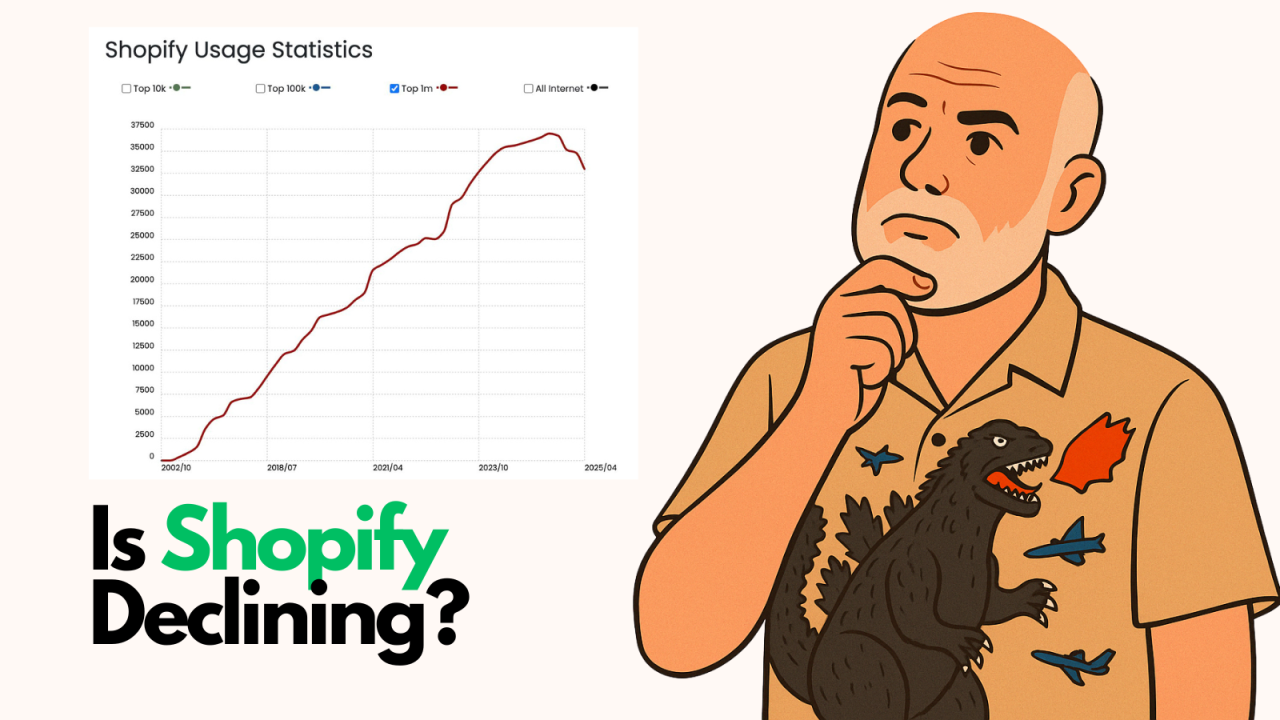
In 1995, I built my first B2B website for my then computer assembly company. It was a mixture of PERL scripts and HTML and was very 1990s (If you can imagine). Companies would fill out long forms and submit for quotes. Manual work, but it meant businesses could easily get their requirements to me.
Today, organizations face thousands of platform options with instant quotes, AI-powered recommendations, and bots streamlining the entire process. Picture this: a manufacturing company running SAP discovers Sana Commerce after spending months evaluating mainstream platforms. Or an enterprise already invested in Adobe ecosystem realizes Adobe Commerce integrates seamlessly with their existing AEM and analytics stack. A startup finds Shopware or OroCommerce are a perfect fit for custom b2b build, while an established distributor discovers BigCommerce handles their SaaS requirements flawlessly.
Sometimes the most niche platforms become your perfect fit. But with literally thousands of choices spanning from headless solutions to industry-specific platforms, the selection process has become the biggest challenge. From 30 years of implementing and partnering with platforms, I've learned the biggest challenge isn't finding options. It's avoiding decision paralysis while evaluating them. You should look at multiple platforms, but without guidance, that leads to analysis overload.
This is why I advise businesses on platform selection. You may already have a relationship with an agency, but they often specialize in one discipline. That means you don't get a 360-degree perspective on what truly fits your needs.
The B2B platform market exploded. Shopify Plus, BigCommerce Enterprise, Adobe Commerce, custom builds, headless solutions, composable architectures, Sana Commerce, Shopware, VTEX for marketplace-first approaches. Each vendor promises everything. Each demo looks perfect. Each sales team has the "ideal solution."
There are so many great choices that we can't possibly list them all here. The reality: organizations evaluate mainstream platforms only to discover that a specialized solution like Thirstie is purpose-built for their beverage business. Enterprises invested in Adobe's ecosystem realize Adobe Commerce's native integration with AEM could save them six months of development. Startups find that Shopware's flow builder and modern architecture better align with their greenfield approach than those of established platforms.
Sometimes the perfect platform isn't the most popular one. It's the one that solves your specific challenges without forcing workarounds.
The real challenge? Cutting through vendor noise to find what actually fits your business reality, especially when you may already have agency relationships that only show you their specialty, not the full landscape of possibilities.
Platform-specific partners create a hidden bias problem. The Shopify specialist will demonstrate why Shopify solves everything. The Adobe Commerce expert explains why their platform is enterprise-grade perfection. The custom development team shows unlimited possibilities.
None of them start with your requirements.
They start with their preferred solution.
Self-Hosted vs. SaaS Isn't Just About Control
If you need extensive customization and complex API integrations, self-hosted solutions offer unlimited development potential. SaaS platforms create hard walls. You can build anything on self-hosted. SaaS tells you what you can't do and then you have to find a third party around the problem.
This isn't theoretical. B2B operations often require deep ERP integrations, custom pricing engines, or specialized workflow automation. Self-hosted platforms let you modify core functionality. SaaS platforms limit you to their predefined API endpoints and rate limits.
The AI Acceleration Factor
Four years ago, nobody planned for AI integration in their platform architecture. Today, it's essential. Tomorrow brings changes we can't anticipate. Your platform choice needs adaptability, not just current feature completeness.
The rise of agentic commerce and AI buying agents is already transforming B2B purchasing. Roy Rubin, founder of Magento, predicts we won't even need websites in the future as AI agents handle the entire procurement process directly between systems. While that timeline remains uncertain, the trajectory is clear.
The platforms that survive and thrive will be those that can evolve with technological shifts. Rigid architectures become technical debt when the next breakthrough emerges.
Tier 1: Architecture Decisions (Foundation) The deployment model must match your customization needs, which requires an honest assessment of your technical capabilities. API flexibility becomes critical for future unknowns, and sometimes the answer isn't a traditional platform at all. Maybe you need a marketplace solution instead of building your own storefront.
Tier 2: Core Business Requirements (Operations) Integration ecosystem compatibility with your existing systems determines operational success. Scalability architecture must align with realistic growth projections, not wishful thinking. Compliance frameworks need to match your actual industry realities, not generic requirements.
Tier 3: Competitive Features (Differentiation) Customer experience enhancement capabilities separate good platforms from great ones. Operational efficiency improvements drive long-term ROI. Innovation platform potential determines whether your technology investment becomes a competitive advantage or operational overhead.
Technology hell isn't just implementation failure. It's discovering platform limitations after a significant investment.
The One Million Dollar Surprise
Organizations complete their implementation only to discover core functionality gaps that weren't apparent during evaluation. What seemed perfect in controlled demos fails when handling real production loads and complex business processes. Development teams scramble to build workarounds, creating mountains of technical debt that slow every future enhancement.
The Customization Trap
SaaS platforms promise flexibility during the sales process until you actually need to customize something critical to your business. API limitations surface during the integration phase, forcing compromises in essential workflows.
Feature requests that seem reasonable get relegated to "roadmap items" with no delivery timeline, leaving you stuck with functionality that almost meets your needs. Sometimes the workaround is impossible. That is were self-hosted makes everything possible.
Platform specialists push their preferred solutions regardless of fit. The Shopify expert will find reasons why Shopify works. The Adobe specialist explains why you need enterprise features. The custom developer shows unlimited possibilities.
Each has financial incentives to sell their specialty, not solve your problem.
Bad B2B platform choices compound over time. Customers learn broken workflows and resist changes to familiar processes, even when those processes are inefficient. Teams build their daily operations around platform limitations, creating organizational dependency on suboptimal systems.
Integration debt accumulates, making future migration exponentially more expensive as every connected system becomes another complexity to untangle. Meanwhile, competitors gain ground as your resources focus on fighting technology problems instead of serving customers and growing the business.
After years of B2B, I've seen lots of platform promises and different implementation realities. The difference between success and technology hell isn't the platform choice. It's the selection methodology.
Platform-agnostic evaluation means starting with your requirements, not vendor capabilities. It requires honest technical assessment of your organizational capabilities and understanding true customization needs versus nice-to-have features. Most importantly, it involves evaluating vendor bias in partner recommendations to ensure you're getting unfiltered guidance.
The Framework Advantage delivers systematic evaluation using proven methodologies that cut through marketing promises to operational realities. It means understanding hidden costs and limitations before implementation begins and matching platform architecture to actual business needs rather than theoretical capabilities.
B2B platform selection determines whether technology accelerates your business or anchors it to problems. The difference isn't finding the "best" platform. It's finding the right platform for your specific requirements and capabilities.
I provide platform-agnostic B2B evaluation services. No vendor partnerships. No platform preferences. Just systematic assessment of what actually fits your business reality and technical capabilities.
Facing a B2B platform decision? Let's discuss your requirements without the sales pitch. The right choice starts with independent analysis.
Connect with me to explore platform-agnostic evaluation for your B2B needs.

Following up on my earlier post about BigCommerce's rebrand announcement, I got my hands on theCleveland...

By Brent W Peterson AI vs Shopify: Is Platform Dominance Ending in 2025?

"No CTO ever got fired for choosingShopify"